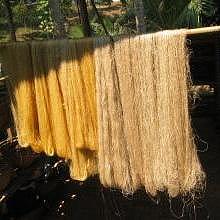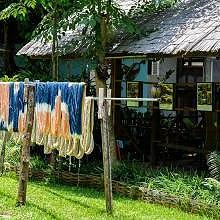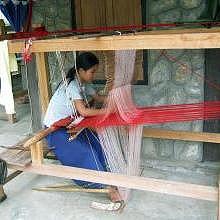Lao silk is a wild silk, and is defined by its exclusively hand-made method of manufacture.
Because of this, it has a more unrefined look, which is more natural, not as smooth as its Indian, European and Chinese counterparts, which makes it noble, natural, and most of it is 100% bio.
Pure craftsmanship, with no machines
Nearly all the silk manufacturing countries (Japan, China, Thailand, etc.) have chosen to industrialize their craft, especially because the cost for the workers they need, is more and more expensive. Laos stays one of the countries where natural silk is ordinary and affordable.
In Laos, sericulture (silk farming) is organised in production units where the reeling, colouring and spinning is all done by hand, often by women. Weaving is rarely done with semi-automatic looms : most of the time, the man or the woman manually weaves about 1 metre per day, when making simple designs, and only a few centimetres for the more complicated designs.
In Laos, each person has his own technique
In this country, each family develops their own technique and sometimes their own decorative patterns, although most of them are reproductions of traditional designs and ikats (weaving that uses a resist dyeing process, similar to tie-dye on either the warp or the weft, before the threads are woven to create the pattern) specific to the artist’s ethnical group.
In this way, each region and even each family produces an individual silk, according to their particular method of reeling and forming, so obtaining mat or lustrous silks, which are more or less thick and more or less soft. The region of Sam Neua, on the Vietnamese border is recognised for its thick and extremely solid silk whereas, further South, in the region of Xieng Kouang, the silk is finer, lighter and softer.
Numerous stages
First of all, the silk worms must be fed 4 times a day, with fresh leaves from the white mulberry. These larvae must eat, without stopping, for 1 month. At the end of that time, the worms are put onto spines "hedgehogs" between which, for a few days, they can weave to produce their protective cocoon.
When the worms are ready to pierce the cocoon, they are scalded in hot water, then the silk is extracted by alkaline baths. The threads are then boiled in pure water so as to obtain the required softness. The more times this operation is repeated, the softer the silk; the spinner needs to have an excellent knowledge of the raw material he or she is using.
No less than 5000 cocoons are needed to make 1 kilo of raw silk, using a process that can last 8 days.
Then come the different stages of spinning (see the video), dyeing (see details), then weaving. All these stages are done manually. To make a long, traditional stole, it would sometimes take more than a month’s work.
Different qualities of silk
Several qualities of thread are obtained : a thread with an uneven texture will be extracted, when the whole cocoon is used (mai sao lueai), a thread with a rougher texture, by using the outside of the cocoon (pueak mai) a smooth, fine thread, by using only the interior of the cocoon, this is royal silk (mai nyot).
At this stage, the spinner’s knowledge and dexterity are very important to form the final thread (the one that will make the difference to the weaving) of 1, 2, 3 or 4 folds, the 1st fold giving the finest, softest, more resistant and more lustrous silk. According to the pressure of the fingers during spinning, according to the technique of joining the threads, the silk will be more or less smooth.
A craftsmanship for the locals
The first Lao silk market is local. Laotians have kept their traditions, and use pieces of silk (shawls, scarves, skirts, stoles, etc.) for traditional Buddhist or Shaman ceremonies, or simply for marriages, official meetings, etc.
Sericulture is often taken up by families so as to increase their income which is relatively low in Laos. It needs a lot of maintenance, especially feeding the hungry larvae 4 times a day with fresh Mulberry leaves. A kilo of silk (which, as you can see, is a lot of work) is worth about 25 dollars in Laos, which enables the making of pieces of cloth affordable for the Laotians.
Article extracted from the site Sanlao.org, The Craftsmen of Laos











